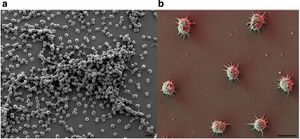Altiarchaeales: Difference between revisions
No edit summary |
|||
| Line 53: | Line 53: | ||
<http://onlinelibrary.wiley.com/doi/10.1111/j.1365-2958.2005.04294.x/full>. | <http://onlinelibrary.wiley.com/doi/10.1111/j.1365-2958.2005.04294.x/full>. | ||
4. Probst, Alexander J., and Christine Moissl-Eichinger. "“Altiarchaeales”: Uncultivated Archaea from the Subsurface." Life. MDPI, June 2015. Web. 22 Apr. 2017 | 4. <ref> [https://www.ncbi.nlm.nih.gov/pubmed/25984733 Probst, Alexander J., and Christine Moissl-Eichinger. "“Altiarchaeales”: Uncultivated Archaea from the Subsurface." Life. MDPI, June 2015. Web. 22 Apr. 2017] | ||
5. Borrel, Guillaume, Panagiotis S. Adam, and Simonetta Gribaldo. "Methanogenesis and the Woodâ“Ljungdahl Pathway: An Ancient, Versatile, and Fragile Association." Genome Biology and Evolution 8.6 (2016): 1706-711 | 5. Borrel, Guillaume, Panagiotis S. Adam, and Simonetta Gribaldo. "Methanogenesis and the Woodâ“Ljungdahl Pathway: An Ancient, Versatile, and Fragile Association." Genome Biology and Evolution 8.6 (2016): 1706-711 | ||
Revision as of 04:22, 27 April 2017
Section

By [Benjamin A. Canniff]
At right is a sample image insertion. It works for any image uploaded anywhere to MicrobeWiki.
The insertion code consists of:
Double brackets: [[
Filename: PHIL_1181_lores.jpg
Thumbnail status: |thumb|
Pixel size: |300px|
Placement on page: |right|
Legend/credit: Electron micrograph of the Ebola Zaire virus. This was the first photo ever taken of the virus, on 10/13/1976. By Dr. F.A. Murphy, now at U.C. Davis, then at the CDC.
Closed double brackets: ]]
Other examples:
Bold
Italic
Subscript: H2O
Superscript: Fe3+
Introduce the topic of your paper. What is your research question? What experiments have addressed your question? Applications for medicine and/or environment?
Sample citations: [1]
[2]
A citation code consists of a hyperlinked reference within "ref" begin and end codes.
Higher Order Taxa
Kingdom:Proteoarchaeota
- Domain: Archaea
- Phylum: Euryarchaeota
- Class: Unknown
- Order: Altiarchaeales
- Family: Altiarchaeaceae
- Order: Altiarchaeales
- Class: Unknown
- Phylum: Euryarchaeota
Section 2
Include some current research, with at least one figure showing data.
Section 3
Include some current research, with at least one figure showing data.
Section 4
Conclusion
References
1. Bird, Jordan T., Brett J. Baker, Alexander J. Probst, Mircea Podar, and Karen G. Lloyd. "Culture Independent Genomic Comparisons Reveal Environmental Adaptations for Altiarchaeales." Frontiers in Microbiology 7 (2016) <https://www.ncbi.nlm.nih.gov/pmc/articles/PMC4975002/pdf/fmicb-07-01221.pdf>.
2. Probst, Alexander J., Thomas Weinmaier, Kasie Raymann, Alexandra Perras, Joanne B. Emerson, Thomas Rattei, Gerhard Wanner, Andreas Klingl, Ivan A. Berg, Marcos Yoshinaga, Bernhard Viehweger, Kai-Uwe Hinrichs, Brian C. Thomas, Sandra Meck, Anna K. Auerbach, Matthias Heise, Arno Schintlmeister, Markus Schmid, Michael Wagner, Simonetta Gribaldo, Jillian F. Banfield, and Christine Moissl-Eichinger. "Biology of a Widespread Uncultivated Archaeon That Contributes to Carbon Fixation in the Subsurface." Nature Communications 5 (2014) <https://www.nature.com/articles/ncomms6497>.
3. Moissl, Christine, Reinhard Rachel, Ariane Briegel, Harald Engelhardt, and Robert Huber. "The Unique Structure of Archaeal ‘hami’, Highly Complex Cell Appendages with Nano‐grappling Hooks." Molecular Microbiology. Blackwell Publishing Ltd, 07 Mar. 2005. Web. 21 Apr. 2017 <http://onlinelibrary.wiley.com/doi/10.1111/j.1365-2958.2005.04294.x/full>.
5. Borrel, Guillaume, Panagiotis S. Adam, and Simonetta Gribaldo. "Methanogenesis and the Woodâ“Ljungdahl Pathway: An Ancient, Versatile, and Fragile Association." Genome Biology and Evolution 8.6 (2016): 1706-711
<https://www.ncbi.nlm.nih.gov/pmc/articles/PMC4943185/pdf/evw114.pdf>.
Authored for BIOL 238 Microbiology, taught by Joan Slonczewski, 2017, Kenyon College.
